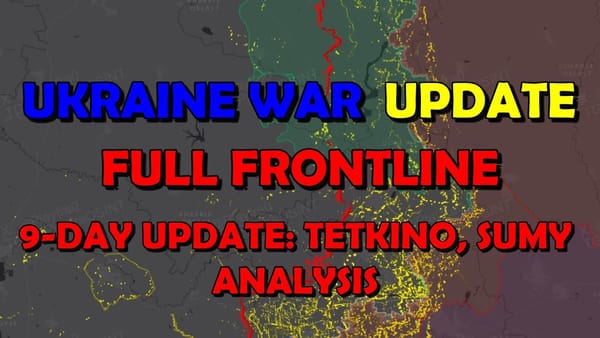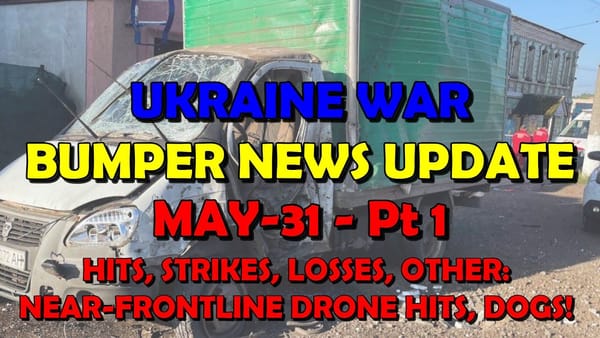Ukraine Conflict: Full Frontline Update
Table of Contents 📖
"Russia is more formidable than many pro-Ukrainian analysts suggest, but weaker than pro-Russian camp portrays. Russia does not have unlimited resources, whether in terms of personnel budget or societal support. While it can be defeated, this will not happen if Ukraine and its western partners continue to make the same mistakes."
Hello Team
🎦 00:00-01:27⏩
Jonathan welcomes viewers to a Ukraine War Frontline Update. He acknowledges a slight delay in posting this update due to a recent cinema trip to see 'Alien: Romulus' (which he highly recommends) and some enjoyable wine consumption. Jonathan points out that there has been a lot of activity in the past couple of days and he anticipates this update might take a while. He also notes that Andrew Perpetua has already released a mapping update and live stream in the meantime, but this information predates these events.
Return to top⤴️
📍 FRONT-LINE UPDATE -🗺️ MAP LEGEND

Eastern Frontline Overview: Russian Gains and Ukrainian Challenges
🎦 01:27-02:14⏩
Jonathan observes significant activity ("tremendous pinnage") on the pro-Russian mapper, particularly along the eastern front line, indicating notable Russian advances. He compares the situation to two different "pitches":
- Kursk: Ukrainians appear to be making gains.
- Donbas region (Prokrosk, Turetsk, New York, Vuklada): Russians seem to be more active and potentially resurging.
Jonathan reminds viewers to interpret Syriac maps with caution.
Return to top⤴️
Kursk Counteroffensive: Ukrainian Advances and Russian Defensive Efforts
🎦 02:14-14:53⏩
Jonathan analyses the situation in Kursk, noting Ukrainian pressure and gains in several areas. He highlights discrepancies between Syriac maps (which show significant Ukrainian advances) and Andrew Perpetua's maps, suggesting those gains may already be reflected in Perpetua's earlier updates. Key points include:
- Limited Fighting, Ukrainian Trench Digging: Both sides report less intense fighting, indicating a potential shift towards positional warfare as opposed to rapid Ukrainian advances. Notably, Ukrainians are digging trenches, preparing for a prolonged conflict.
- Russian Reinforcements and Militia Formation: Russians are deploying a private military company ("Bears Brigade") from Burkina Faso to bolster defenses in Kursk. This suggests a reluctance to divert troops from the successful Prokrosk offensive, highlighting a strategic dilemma for Putin. Additionally, Russia is forming local militias with limited training in Kursk, indicating resource constraints.
- Geolocated Footage and Shifting Front Lines: Geolocated footage reveals Ukrainian infantry operating south of Kirovka, near Kamyshevka, which falls within a contested "grey zone." Discrepancies between Syriac maps and Perpetua's mapping are evident, with significant differences in Russian-controlled areas.
- Ukrainian Control of Nechayev and Nechnyaya Paravaia: Russian sources confirm Ukrainian control over Nechayev and Nechnyaya Paravaia, further highlighting Ukrainian gains in the region.
- Slower Ukrainian Advance, Grinding Gains: While Ukrainians continue to advance, the pace has slowed due to increased Russian defenses. This aligns with Surskyky's assessment that the offensive operation continues but gains are becoming more grinding.
- Importance of Electronic Warfare: Daniela, a guest on a recent live stream, emphasises the role of Ukrainian electronic warfare in countering Russian drone activity. The Ukrainians successfully disrupted Russian communications and FPV drones during the Kursk offensive, highlighting the significance of these systems on the modern battlefield.
Jonathan mentions his personal involvement in supporting an electronic warfare battalion and encourages viewers to consider donating.
Return to top⤴️
Kharkiv Front: Reduced Russian Activity and Potential Troop Redeployments
🎦 14:53-16:29⏩
In Kharkiv, Syriac maps indicate Russian setbacks northeast of Vovchansk. This coincides with the Institute for the Study of War's report of a significant decrease in Russian attacks in the region, likely due to troop redeployments to defend Kursk.
Return to top⤴️
Intensified Russian Offensives and the Impact of Approaching Autumn
🎦 16:29-17:04⏩
Jonathan acknowledges the intensity of recent Russian offensives across various fronts, suggesting a strategic urgency to achieve objectives before the onset of unfavorable weather conditions in autumn. The approaching rain and mud are expected to hinder military operations significantly.
Return to top⤴️
Kupyansk-Svatove-Kreminna Front: Fluid Front Lines and Russian Pressure
🎦 17:04-20:13⏩
Jonathan observes considerable activity on the Kupyansk-Svatove-Kreminna front, primarily based on Syriac maps. Key observations include:
- Conflicting Gains and Losses Near Tabayivka and Pishchane: Syriac maps show a back-and-forth struggle near Tabayivka and Pishchane, with Russians making advances southwest of Pishchane but Ukrainians recapturing positions northwest of Tabayivka. This area's proximity to the strategically important Oskil River raises concerns, as Ukrainian control of the region, even if only symbolic, remains important.
- Russian Advances Near Delmachivka and Torska: Further south, Russians are reportedly pushing west of Delmachivka towards Jerelna and making gains north of Turney and Torska, potentially threatening Ukrainian positions near the Zherebets River.
- Discrepancies Between Mappers Persist: Jonathan reiterates the need for caution when interpreting Syriac maps, noting substantial discrepancies compared to Andrew Perpetua's mapping, particularly regarding the extent of Russian control.
Chasiv Yar: Debunking Russian Control Claims and Ukrainian Resilience
🎦 20:13-21:17⏩
Jonathan addresses the claim of Russians controlling 40% of Chasiv Yar, deeming it inaccurate based on Andrew Perpetua's analysis and the lack of supporting evidence from Syriac maps. He highlights that while Russians might control some surrounding farmland and the canal micro district, their presence within Chasiv Yar proper remains limited. Importantly, Russians are reportedly suffering heavy losses attempting to cross the canal, signifying Ukrainian resilience in this area.
Return to top⤴️
Turetsk: Stable but Costly Fighting, Russian Gains, and Comparisons to Bakhmut
🎦 21:17-23:48⏩
Jonathan shifts focus to Turetsk, noting that while the situation has stabilized compared to previous weeks, fighting remains fierce.
- Ukrainian Losses and Russian Gains: Andrew Perpetua highlights significant Ukrainian troop losses in Turetsk, contrasting with heavy Russian casualties in Chasiv Yar. Syriac maps, however, indicate continued Russian advances in Turetsk, raising concerns about the long-term viability of Ukrainian defenses.
- Devastation and Comparisons to Bakhmut: The level of destruction in Turetsk is alarming, drawing comparisons to the ravaged city of Bakhmut.
- Russian Advances West of New York: Adding to Ukrainian concerns, Russians are making gains west of New York, further solidifying their control in this part of the Donbas.
Prokrosk: A Deep Dive into Russian Successes, Ukrainian Challenges, and Strategic Implications
🎦 23:48-33:25⏩
The situation in Prokrosk emerges as a significant concern. Jonathan emphasizes the alarming speed and scale of Russian advances in this area. Key points include:
- Doubling of Controlled Territory and Ukrainian Losses: Since the start of the Kursk counteroffensive, Russia has doubled the amount of territory it controls in the Prokrosk area, indicating a strategic shift of resources and a determined offensive. Ukrainian forces are reportedly retreating and ceding ground, potentially aiming to consolidate defenses along more favorable lines.
- Factors Contributing to Russian Gains: Jonathan attributes Russian successes in Prokrosk to various factors:
- Effective use of tunnels and guided glide bombs.
- Artillery superiority.
- Ukrainian ammunition shortages.
- Insufficient Ukrainian troop deployments.
- Strategic Importance and Potential for Encirclement: Jonathan highlights the strategic importance of Prokrosk and the vulnerability of surrounding areas like Velyka Novosilka, Vuhledar, and Kurakhove. He expresses concern that if Russia manages to advance further, it could encircle and capture these strategically vital locations.
- Heavy Russian Equipment Losses: Despite territorial gains, Andrew Perpetua emphasizes that Russia is sustaining heavy equipment losses in this area, citing a recent incident where 14 out of 17 Russian vehicles were destroyed in a single Ukrainian attack.
- Need for Effective Ukrainian Defense and Counteroffensives: Given the rapid deterioration in Prokrosk, Jonathan stresses the urgent need for Ukraine to implement effective defensive measures and potentially launch counteroffensives to halt the Russian advance.
- Syrian Maps Show Additional Russian Gains: Syriac maps indicate further Russian gains:
- North of Mykhailivka.
- Around Vodiane and Pavlivka (areas previously retaken by Ukraine).
- Near Urozhaine (pushing north of the settlement).
- Robotyne (gradually pushing Ukrainian forces back to their pre-counteroffensive lines).
- Overall Assessment of the Situation: Jonathan expresses serious concern over the situation in Prokrosk and the broader region south of Chasiv Yar, acknowledging that the situation is developing poorly for Ukraine.
Tataragami's Analysis of the Prokrosk Situation, Western Aid, and Russian Capabilities
🎦 33:25-39:25⏩
Jonathan brings in insights from Tataragami, who offers a more optimistic perspective on Prokrosk, asserting that the situation, while severe, is not hopeless. Tataragami provides a detailed analysis:
- Stabilisation Possible, but Requires Difficult Decisions: Tataragami believes Ukraine has the resources to stabilise the Prokrosk front line, although this will necessitate difficult and potentially unpopular choices.
- Internal and External Factors Impacting Resource Shortages: He attributes recent Ukrainian resource shortages to a combination of internal and external challenges. Internal factors include:
- Delayed mobilisation.
- Ineffective recruitment processes.
- An inflexible military command culture.
- Government struggles in balancing public opinion with necessary war measures.
- External challenges include:
- Delays in Western aid delivery.
- Restrictions on the use of supplied weapons.
- Insufficient increases in Western military production to meet Ukrainian needs.
- Impact of Delayed Aid and Inadequate Defenses: Tataragami argues that delays in US aid, hampered by an isolationist faction in Congress, contributed to the fall of Avdiivka and the current challenges in Prokrosk. He criticises Ukrainian leadership for overlooking inadequate defenses behind Avdiivka and overstretching already depleted brigades.
- Critique of Tataragami's Contradictory Stance on Reinforcements: Jonathan challenges Tataragami's seemingly contradictory viewpoints. Tataragami suggests that sending reserves to Kursk weakened Prokrosk, while simultaneously criticizing the earlier decision to reinforce Bakhmut instead of withdrawing. Jonathan argues for consistency in strategy, advocating for either a commitment to defending both Prokrosk and Bakhmut or a strategic withdrawal from both.
- Critique of Western Sanctions and Russia's Economic Resilience: Tataragami criticises the West's failure to fully enforce sanctions on Russia, enabling Moscow to maintain and even expand its military production. He suggests that some Western countries prioritised potential post-war economic ties with Russia over crippling its war effort. This leniency, Tataragami argues, allowed Russia to increase military recruitment incentives without facing economic collapse.
- Realistic Assessment of Russian Capabilities and the Need for Increased Western Support: Tataragami offers a balanced assessment of Russian capabilities, acknowledging its strengths but also its limitations in terms of personnel, budget, and societal support. He contends that while Russia can be defeated, it requires the West to provide Ukraine with the necessary resources and support to secure a decisive victory. Tataragami warns against forcing Ukraine into negotiations without a strong position, drawing parallels to the failures of the Minsk agreements. He emphasises that now is the time for the West to commit to fully supporting Ukraine.
- Ukrainian Resilience and Defiance: Despite facing a formidable opponent, Tataragami highlights Ukraine's remarkable resilience and ability to defy expectations. He cites examples such as:
- Successful defense of Kyiv, Chernihiv, and Sumy.
- The Kharkiv counteroffensive.
- The liberation of Kherson.
- Strikes on targets within Russia.
- Significant damage inflicted on the Black Sea fleet.
- Inflicting substantial Russian casualties.
- Jonathan echoes Tataragami's call for increased Western support, including lifting restrictions on weapon use to allow Ukraine to strike deeper into Russian territory.
Wrap Up
🎦 39:25-39:53⏩
Jonathan concludes the update by expressing his hope that, despite the delays, the information provided is helpful. He signs off and thanks his viewers for watching.
Return to top⤴️



